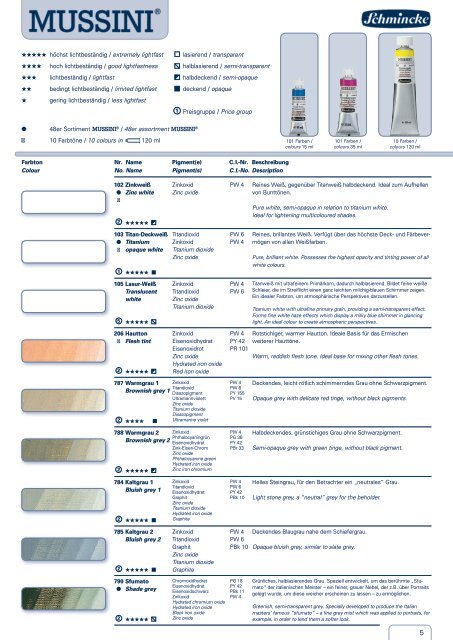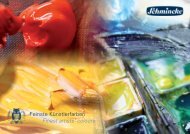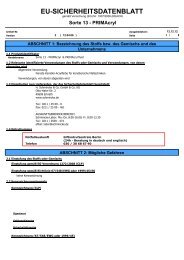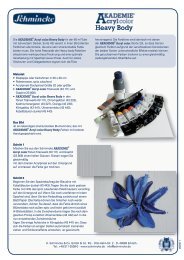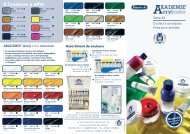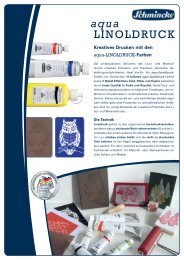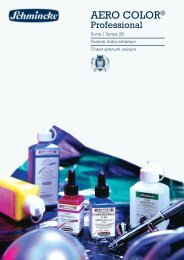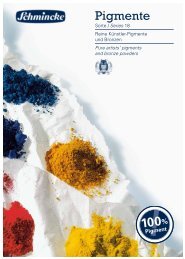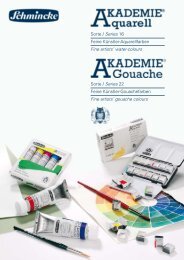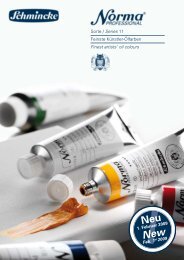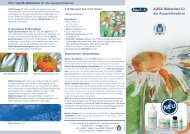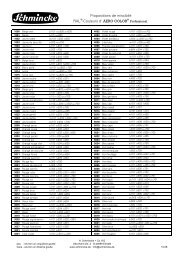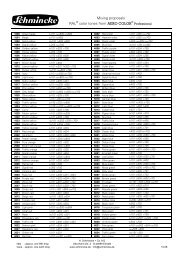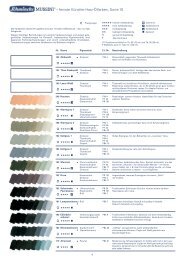Farbkarte - Schmincke
Farbkarte - Schmincke
Farbkarte - Schmincke
Sie wollen auch ein ePaper? Erhöhen Sie die Reichweite Ihrer Titel.
YUMPU macht aus Druck-PDFs automatisch weboptimierte ePaper, die Google liebt.
HHHHH höchst lichtbeständig / extremely lightfast lasierend / transparent<br />
HHHH hoch lichtbeständig / good lightfastness halblasierend / semi-transparent<br />
HHH lichtbeständig / lightfast halbdeckend / semi-opaque<br />
HH bedingt lichtbeständig / limited lightfast deckend / opaque<br />
H gering lichtbeständig / less lightfast<br />
l 48er Sortiment MUSSINI ® / 48er assortment MUSSINI ®<br />
1<br />
Preisgruppe / Price group<br />
� 10 Farbtöne / 10 colours in 120 ml 101 Farben /<br />
colours 15 ml<br />
Farbton Nr. Name Pigment(e) C. I.-Nr. Beschreibung<br />
Colour No. Name Pigment(s) C. I.-No. Description<br />
102<br />
l<br />
�<br />
2<br />
103<br />
l<br />
�<br />
1<br />
Zinkweiß<br />
Zinc white<br />
HHHHH<br />
Titan-Deckweiß<br />
Titanium<br />
opaque white<br />
HHHHH ■<br />
105 Lasur-Weiß<br />
Translucent<br />
white<br />
Zinkoxid<br />
Zinc oxide<br />
Titandioxid<br />
Zinkoxid<br />
Titanium dioxide<br />
Zinc oxide<br />
Zinkoxid<br />
Titandioxid<br />
Zinc oxide<br />
Titanium dioxide<br />
5 HHHHH<br />
206 Hautton Zinkoxid<br />
� Flesh tint Eisenoxidhydrat<br />
Eisenoxidrot<br />
Zinc oxide<br />
Hydrated iron oxide<br />
2 HHHHH Red iron oxide<br />
787 Warmgrau 1 Zinkoxid<br />
Titandioxid<br />
Brownish grey 1 Disazopigment<br />
Ultramarinviolett<br />
Zinc oxide<br />
Titanium dioxide<br />
Disazopigment<br />
2 HHHH ■ Ultramarine violet<br />
788 Warmgrau 2 Zinkoxid<br />
Phthalocyaningrün<br />
Brownish grey 2 Eisenoxidhydrat<br />
Zink-Eisen-Chrom<br />
Zinc oxide<br />
Phthalocyanine green<br />
Hydrated iron oxide<br />
2 HHHHH<br />
Zinc iron chromium<br />
784 Kaltgrau 1<br />
Bluish grey 1<br />
Zinkoxid<br />
Titandioxid<br />
Eisenoxidhydrat<br />
Graphit<br />
Zinc oxide<br />
Titanium dioxide<br />
Hydrated iron oxide<br />
2 HHHHH ■ Graphite<br />
785 Kaltgrau 2 Zinkoxid<br />
Bluish grey 2 Titandioxid<br />
Graphit<br />
Zinc oxide<br />
Titanium dioxide<br />
2 HHHHH ■ Graphite<br />
790 Sfumato<br />
l Shade grey<br />
Chromoxidhydrat<br />
Eisenoxidhydrat<br />
Eisenoxidschwarz<br />
Zinkoxid<br />
Hydrated chromium oxide<br />
Hydrated iron oxide<br />
Black iron oxide<br />
2 HHHHH<br />
Zinc oxide<br />
PW 4 Reines Weiß, gegenüber Titanweiß halbdeckend. Ideal zum Aufhellen<br />
von Bunttönen.<br />
PW 6<br />
PW 4<br />
PW 4<br />
PW 6<br />
PW 4<br />
PY 42<br />
PR 101<br />
PW 4<br />
PW 6<br />
PY 155<br />
PV 15<br />
PW 4<br />
PG 36<br />
PY 42<br />
PBr 33<br />
PW 4<br />
PW 6<br />
PY 42<br />
PBk 10<br />
PW 4<br />
PW 6<br />
PBk 10<br />
PG 18<br />
PY 42<br />
PBk 11<br />
PW 4<br />
101 Farben /<br />
colours 35 ml<br />
Pure white, semi-opaque in relation to titanium white.<br />
Ideal for lightening multicoloured shades.<br />
Reines, brillantes Weiß. Verfügt über das höchste Deck- und Färbevermögen<br />
von allen Weißfarben.<br />
Pure, brilliant white. Possesses the highest opacity and tinting power of all<br />
white colours.<br />
Titanweiß mit ultrafeinem Primärkorn, dadurch halblasierend. Bildet feine weiße<br />
Schleier, die im Streiflicht einen ganz leichten milchig-blauen Schimmer zeigen.<br />
Ein idealer Farbton, um atmosphärische Perspektiven darzustellen.<br />
Titanium white with ultrafine primary grain, providing a semi-transparent effect.<br />
Forms fine white haze effects which display a milky blue shimmer in glancing<br />
light. An ideal colour to create atmospheric perspectives.<br />
Rotstichiger, warmer Hautton. Ideale Basis für das Ermischen<br />
weiterer Hauttöne.<br />
Warm, reddish flesh tone. Ideal base for mixing other flesh tones.<br />
Deckendes, leicht rötlich schimmerndes Grau ohne Schwarzpigment.<br />
Opaque grey with delicate red tinge, without black pigments.<br />
Halbdeckendes, grünstichiges Grau ohne Schwarzpigment.<br />
Semi-opaque grey with green tinge, without black pigment.<br />
Helles Steingrau, für den Betrachter ein „neutrales“ Grau.<br />
Light stone grey, a “neutral” grey for the beholder.<br />
Deckendes Blaugrau nahe dem Schiefergrau.<br />
Opaque bluish grey, similar to slate grey.<br />
10 Farben /<br />
colours 120 ml<br />
Grünliches, halblasierendes Grau. Speziell entwickelt, um das berühmte „Sfumato“<br />
der italienischen Meister – ein feiner, grauer Nebel, der z.B. über Portraits<br />
gelegt wurde, um diese weicher erscheinen zu lassen – zu ermöglichen.<br />
Greenish, semi-transparent grey. Specially developed to produce the Italian<br />
masters’ famous “sfumato” – a fine grey mist which was applied to portraits, for<br />
example, in order to lend them a softer look.<br />
5
6<br />
792 Dove<br />
Eisenoxidrot<br />
Dove grey Zinkoxid<br />
Eisenoxidschwarz<br />
Red iron oxide<br />
Zinc oxide<br />
2 HHHHH ■ Black iron oxide<br />
782 <strong>Schmincke</strong> Ultramarinblau<br />
l Paynesgrau Eisenoxidrot<br />
<strong>Schmincke</strong> Ruß<br />
Payne’s grey Ultramarine blue<br />
Red iron oxide<br />
3 HHHH Lamp black<br />
781 Lampenschwarz Ruß<br />
l Lamp black Lamp black<br />
1<br />
780<br />
�<br />
1<br />
783<br />
l<br />
1<br />
779<br />
l<br />
2<br />
236<br />
l<br />
3<br />
Atrament<br />
Atrament black<br />
HHHH<br />
Lasur-Oxid-Gelb<br />
Translucent<br />
yellow oxide<br />
HHHHH<br />
232 Neapelgelb<br />
dunkel<br />
Naples yellow<br />
deep<br />
4<br />
HHHHH ■<br />
231 Neapelgelb hell<br />
Naples yellow<br />
light<br />
4<br />
HHHHH ■<br />
Perylen<br />
Perylene<br />
Eisenoxidhydrat<br />
Hydrated iron oxide<br />
Chrom-Antimon-<br />
Titangelb<br />
Chromium-antimonytitanium<br />
yellow<br />
Chrom-Antimon- PBr 24<br />
Titangelb<br />
Rutil-Nickel-Zinn-Titan PY 53<br />
Chromium-antimonytitanium<br />
yellow<br />
Rutil-nickel-tin-titanium<br />
224 Jaune brillant Zinkoxid<br />
PW 4<br />
Brilliant yellow Chrom-Antimon-Titangelb PBr 24<br />
Rutil-Nickel-Zinn-Titan<br />
Zinc oxide<br />
Chromium-antimonytitanium<br />
yellow<br />
PY 53<br />
1 HHHHH Rutil-nickel-tin-titanium<br />
207 Medievalgelb Zinkoxid<br />
PW 4<br />
l Medieval yellow Titandioxid<br />
PW 6<br />
Rutil-Nickel-Zinn-Titan<br />
Zinc oxide<br />
Titanium dioxide<br />
PY 53<br />
3 HHHHH ■ Rutil-nickel-tin-titanium<br />
208<br />
l<br />
4<br />
HHHHH ■<br />
Elfenbein-<br />
schwarz<br />
Ivory black<br />
HHHHH ■<br />
Mineralschwarz<br />
Mineral black<br />
HHHHH ■<br />
Ural-Gelbgrün<br />
Yellowish green<br />
Ural<br />
HHHHH ■<br />
Verkohlungsprodukt<br />
tierischer Herkunft<br />
Carbonized bones of<br />
animals<br />
Kupferchromit<br />
(Spinellschwarz)<br />
Copper chromite<br />
(Black spinel)<br />
Rutil (Ni, Ti, Sb)<br />
Spinell (Co, Zn)<br />
Rutil (Ni, Ti, Sb)<br />
Spinel (Co, Zn)<br />
PR 101<br />
PW 4<br />
PBk 11<br />
PB 29<br />
PR 101<br />
PBk 7<br />
PBk 31 Modernes org. Schwarzpigment. Im Vollton sehr tief, in der Lasur nahe einem<br />
Russischgrün. Ergibt mit Weiß gemischt grünstichige Grautöne. Atrament war in<br />
römischer Zeit die Bezeichnung für ein sehr kaltes Schwarz.<br />
Modern organic black pigment. Very deep in full tone, close to a Russian green in<br />
glazes. Produces green-tinged grey tones when mixed with white. Atrament was<br />
the name for a very cold black in Roman times.<br />
PY 42 Sehr fein lasierendes, anorganisches Gelb; der Farbton ist etwa wie<br />
ein brillanter gelber Ocker oder sehr gelbe Siena.<br />
Inorganic yellow which produces a very fine glaze effect; the tone is<br />
roughly similar to a brilliant yellow ochre or a very<br />
yellow Sienna.<br />
PBr 24 Warmes, deckendes, fast ockerfarbenes Gelb. Früher aus toxischem<br />
Bleipigment hergestellt, heute eine Nachstellung mit<br />
anorganischen, hoch lichtechten Pigmenten.<br />
Warm, opaque, almost ochre-coloured yellow. Previously produced<br />
from toxic lead pigment, now an imitation with inorganic, highly lightfast<br />
pigments.<br />
PY 53<br />
PG 19<br />
Angenehmes, warmes Dunkelgrau mit einem „Stich“ ins Violette.<br />
Pleasant, warm dark grey with a “hint” of violet.<br />
Traditioneller <strong>Schmincke</strong> Grauton. Kommt einem dunklen Neutralgrau<br />
sehr nahe.<br />
Traditional <strong>Schmincke</strong> grey colour. Very similar to a dark neutral grey.<br />
PBk 7 Besonders feinteiliger Gasruß mit größter Farbtiefe. Dadurch farbstark<br />
und ergiebig.<br />
Particularly fine gas black with maximum depth of colour.<br />
This provides for high intensity and tinting power.<br />
PBk 9 Traditionelles Tiefschwarz, deckend und hoch lichtbeständig. Früher<br />
aus verkohlten Elfenbeinstücken, heute durch trockene<br />
Destillation entfetteter Knochen erzeugt.<br />
Traditional deep black, opaque and lightfast. Formerly obtained from<br />
charred ivory pieces, now produced via the dry distillation of degreased<br />
bones.<br />
PBk 28 „Kühles“ anorganisches, leicht anthrazitfarben schimmerndes<br />
Schwarz. Ergibt mit Weiß gemischt ein blaustichiges Grau.<br />
“Cool”, inorganic black with a gentle tinge of charcoal. Produces a<br />
blue-tinged grey when mixed with white.<br />
Die hellere und gelbere Variante von Neapelgelb dunkel.<br />
The lighter and yellow variant of dark Naples yellow.<br />
Traditioneller Farbton aus anorganischen Pigmenten. Sehr helles, fast<br />
beiges Gelb.<br />
Traditional colour produced from inorganic pigments. Very light, almost<br />
beige yellow.<br />
Blasses, grünliches, deckendes Gelb, mit anorganischen Pigmenten<br />
dem Original nachgestellt. Medievalgelb war das hellste Gelb des<br />
mittelalterlichen Malers.<br />
Pale, greenish, opaque yellow which imitates the original with inorganic<br />
pigments. Medieval yellow was the brightest yellow used by the<br />
Medieval painters.<br />
Aus anorganischen Pigmenten hergestelltes, schwer ermischbares<br />
helles und zartes Grüngelb.<br />
Light, delicate greenish yellow which can hardly be obtained by<br />
mixing, made from inorganic pigments.
216<br />
l<br />
�<br />
3<br />
Zitronengelb<br />
Lemon yellow<br />
HHHH<br />
220 Vanadiumgelb<br />
hell<br />
Vanadium<br />
yellow light<br />
6<br />
HHHHH ■<br />
227 Kadmiumgelb1<br />
hell<br />
Cadmium<br />
yellow 1 light<br />
5<br />
209<br />
l<br />
4<br />
HHHHH ■<br />
Kadmium-<br />
gelbton<br />
Cadmium<br />
yellow tone<br />
HHHHH<br />
221 Vanadiumgelb<br />
dunkel<br />
Vanadium<br />
yellow deep<br />
5<br />
Monoazogelb<br />
Monoazoyellow<br />
Bismutvanadatpigment<br />
Bismuth vanadate<br />
pigment<br />
Cadmium-Zink-Sulfid<br />
Cadmium-zincsulphide<br />
Disazopigment<br />
Disazopigment<br />
Bismutvanadatpigment<br />
Bismuth vanadate<br />
pigment<br />
5 HHHHH ■<br />
228 Kadmiumgelb 2 Cadmium-Zink-Sulfid<br />
mittel<br />
Cadmium-zinc-<br />
Cadmium sulphide<br />
yellow 2 middle<br />
238<br />
l<br />
3<br />
223<br />
l<br />
3<br />
HHHHH ■<br />
Lasur-Gelb<br />
Translucent<br />
yellow<br />
HHHHH<br />
Indischgelb<br />
Indian yellow<br />
HHHHH<br />
229 Kadmiumgelb 3<br />
dunkel<br />
Cadmium<br />
yellow 3 deep<br />
5<br />
HHHHH ■<br />
Azo-Nickel-Komplex<br />
Azo-nickel complex<br />
Metallkomplex<br />
Metal complex<br />
230 Kadmiumorange Cadmium-<br />
Cadmium Sulfoselenid<br />
orange Cadmiumsulphoselenide<br />
6<br />
HHHHH ■<br />
243 Chromorangeton<br />
Chrome<br />
orange tone<br />
4<br />
239<br />
l<br />
3<br />
HHHHH ■<br />
Lasur-Orange<br />
Translucent<br />
orange<br />
HHHH<br />
PY 3 Das klassische, brillante, grünstichige Gelb in der Ölmalerei.<br />
Gute Mischeigenschaften mit Lasur-Cyan; ergibt klare, halblasierende<br />
Grüntöne.<br />
The classic brilliant, green-tinged yellow in oil colouring. Mixes well<br />
with translucent cyan; produces clear, semi-transparent green shades.<br />
PY 184 Enthält ein modernes, deckendes, farbstarkes Pigment. Ergibt ein brillantes, leicht<br />
grünstichiges Gelb. Eine kadmiumfreie Alternative für Kadmiumgelb zitron. Gute<br />
Mischeigenschaften mit Lasur-Cyan, ergibt klare, brillante, deckende Grüntöne.<br />
Contains a modern, opaque pigment with high tinting power. Produces a brilliant,<br />
slightly green-tinted yellow. A cadmiumfree alternative to cadmium yellow. Mixes<br />
well with translucent cyan, produces clear, brilliant, opaque green shades.<br />
PY 35 Gut deckendes, farbstarkes, brillantes Gelb.<br />
Brilliant opaque yellow with high tinting power.<br />
PY 155 Nachstellung von Kadmiumgelb mit organischem Pigment. Farbstark,<br />
halbdeckend, kadmiumfrei.<br />
Imitation of cadmium yellow with inorganic pigment. High tinting<br />
power, semi-opaque, cadmium-free.<br />
PY 184 Enthält ein modernes, deckendes, farbstarkes Pigment. Ergibt ein<br />
rötliches, leicht stumpfes Gelb. Eine chromfreie Alternative<br />
für Chromgelb mittel.<br />
Contains a modern, opaque pigment with high tinting power. Produces<br />
a reddish, slightly dull yellow. A chrome-free alternative to<br />
medium chrome yellow.<br />
PY 35 Gut deckendes, farbstarkes, sattes, rotstichiges Gelb.<br />
Rich, red-tinted yellow with good opacity and tinting power.<br />
PY 150 In dünner Schicht fein lasierendes Zitronengelb. Bei deckendem<br />
Auftrag ein dunkles, fast ockerfarbenes Gelb.<br />
Lemon yellow when applied in a thin layer to produce a fine<br />
glaze. Dark, almost ochre- coloured yellow when applied as an<br />
opaque layer.<br />
PY 153 Indischgelb wurde früher in Indien aus dem Urin von Kühen hergestellt, die mit Mangoblättern<br />
gefüttert wurden. Aus Tierschutzgründen ist die Herstellung heute verboten.<br />
Unser Indischgelb ist eine Nachstellung des lasierenden, orangegelben<br />
Farbenklassikers.<br />
In former times, Indian yellow was produced in India from the urine of cows which<br />
were fed with mango leaves. This method of produc tion is prohibited today, because it<br />
is cruel. Our Indian yellow is an imitation of the classic translucent orange-yellow colour.<br />
Cadmium-Sulfoselenid PO 20<br />
Cadmium-<br />
Hoch deckendes, farbstarkes, brillantes Gelborange.<br />
sulphoselenide<br />
Brilliant yellow-orange with high opacity and tinting power.<br />
Pyrazolochinazolon<br />
Pyrazolochinazolone<br />
Diketo-Pyrrolo-Pyrrol<br />
Diketo-Pyrrolo-Pyrrol<br />
PO 20 Hoch deckendes, farbstarkes, brillantes Orange.<br />
Brilliant orange with high opacity and tinting power.<br />
PO 67 Nachstellung des giftigen Chromorange mit einem ungiftigen,<br />
modernen, deckenden, farbstarken, organischen Pigment. Ein sehr<br />
tiefes, feurig-brillantes Orange.<br />
Imitation of the toxic chrome orange with a non-toxic, modern,<br />
opaque organic pigment with high tinting power. A very deep,<br />
brilliantly fiery orange.<br />
PO 71 Fein lasierender, dunkler und sehr rotstichiger Orangeton.<br />
Ideal zum Ermischen hellster Rottöne.<br />
Finely translucent dark orange shade with pronounced red tinge. Ideal<br />
for mixing to produce very light red shades.<br />
7
8<br />
340<br />
l<br />
4<br />
6<br />
Brillantscharlach Disazokondensation<br />
Brilliant scarlet Disazo condensation<br />
HHHHH<br />
356 Kadmiumrot hell Cadmium-<br />
Cadmium red Sulfoselenid<br />
light<br />
Cadmiumsulphoselenide<br />
364<br />
l<br />
�<br />
3<br />
HHHHH ■<br />
Zinnoberrotton<br />
Vermilion<br />
red tone<br />
HHHHH ■<br />
341 Kadmiumrot<br />
mittel<br />
Cadmium red<br />
middle<br />
7<br />
HHHHH ■<br />
342 Kadmiumrotton<br />
Cadmium<br />
red tone<br />
6<br />
HHHHH ■<br />
357 Kadmiumrot<br />
dunkel<br />
Cadmium red<br />
deep<br />
6<br />
343<br />
l<br />
3<br />
353<br />
l<br />
3<br />
365<br />
l<br />
3<br />
344<br />
l<br />
4<br />
HHHHH ■<br />
Wurzelkrappton<br />
Madder root<br />
tone<br />
HHHHH<br />
Florentinerrot<br />
Florentine red<br />
HHHHH<br />
Lasur-Oxid-Rot<br />
Translucent<br />
red oxide<br />
HHHHH<br />
Krapplack<br />
brillant<br />
Madder lake<br />
brilliant<br />
HHHH<br />
347 Alizarin-<br />
Krapplack<br />
Alizarin<br />
madder lake<br />
4<br />
HHH<br />
346 Krapplack<br />
tief<br />
Madder lake<br />
dark<br />
4<br />
HHHHH<br />
Diketo-Pyrrolo-Pyrrol<br />
Diketo-Pyrrolo-Pyrrol<br />
Cadmium-<br />
Sulfoselenid<br />
Cadmiumsulphoselenide<br />
DPP<br />
Chinacridon<br />
DPP<br />
Quinacridone<br />
Cadmium-<br />
Sulfoselenid<br />
Cadmiumsulphoselenide<br />
Chinacridon<br />
Quinacridone<br />
Perylen<br />
Perylene<br />
Eisenoxidrot<br />
Red iron oxide<br />
Chinacridon<br />
Quinacridone<br />
Anthrachinon, AI<br />
Anthrachinone, AL<br />
Diketo-Pyrrolo-Pyrrol<br />
Diketo-Pyrrolo-Pyrrol<br />
PR 242 Scharlach war früher ein begehrter Farbstoff, er wurde aus einer<br />
in der Lermes-Eiche lebenden Schildlausart gewonnen. Heute wird ein brillantes,<br />
sehr gelbstichiges Rot als „Scharlach“ bezeichnet.<br />
PR 108/<br />
PW 21<br />
In former times, scarlet was a much sought-after colour which was obtained<br />
from a coccid which lives in the lermes oak. Today, the name “scarlet” is given<br />
to a brilliant red with a very pronounced yellow tinge.<br />
Farbstarkes, reines, hoch deckendes Rot, nahe dem Zinnoberrot.<br />
Pure opaque red with high tinting power. Similar to vermilion red.<br />
PR 255 Klassisches Rot. Echter Zinnober ist giftig und hat eine geringe Lichtechtheit,<br />
daher wurde dieser Ton mit einem modernen, organischen Pigment nachgestellt.<br />
Brillantes, deckendes Rot; bläulicher als Scharlachrot, gelber als Karminrot.<br />
PR 108/<br />
PW 21<br />
PR 242<br />
PV 19<br />
PR 108/<br />
PW 21<br />
Classic red. As real cinnabar is toxic and possesses poor light-fastness, this<br />
colour has been imitated with a modern, organic pigment. Brilliant, opaque red,<br />
bluer than scarlet, yellower than carmine.<br />
Farbstarkes, kräftiges, hoch deckendes Rot, dunkler und bläulicher als<br />
Kadmiumrot hell.<br />
Rich opaque red with high tinting power. Darker and bluer than light<br />
cadmium red.<br />
Nachstellung von Kadmiumrot mittel mit organischen Pigmenten.<br />
Farbstark, deckend, kadmiumfrei.<br />
Imitation of cadmium red middle with organic pigments. High tinting<br />
power, opaque, cadmium-free.<br />
Sehr tiefes und blaustichiges Rot. Farbstark und hoch deckend.<br />
Very deep red with a blue tinge. High opacity and tinting power.<br />
PR 206 Fein lasierendes, dunkles, bräunliches Rot. Vergleichbar mit<br />
sehr rötlichem Mahagoni.<br />
Finely translucent dark, brownish red. Comparable with very red<br />
mahogany.<br />
PR 179 Die Perylene gehören zu den lichtechtesten, organischen Pigmenten. Ein lasierendes,<br />
kaltes, etwas braunstichiges Dunkelrot. Florentinerrot bezieht sich auf den alten Florentiner<br />
Lack, der aus Brasilholz gewonnen wurde und einen ähnlichen Farbton hatte.<br />
Perylenes are among the most light-fast organic pigments. A translucent, cold, dark red<br />
with a slight brown tint. Florentine red is based on the old Florentine colour which was<br />
obtained from Brazil wood and was similar in colour.<br />
PR 101 Warmes, fein lasierendes Rotbraun, wird heute auch<br />
oft für die Nachstellung gebrannter Siena verwendet.<br />
Warm, finely translucent reddish brown, commonly used today to<br />
imitate burnt Sienna.<br />
PR 209 Lasierendes, sehr helles Hochrot. Bis auf „Alizarin-Krapplack“sind unsere MUSSINI ®<br />
„Krapp“-lacke Farbtonbezeichnungen; sie werden heute nachgestellt mit sehr lichtechten,<br />
lasierenden, modernen, organischen Pigmenten.<br />
Translucent, very bright deep red. With the exception of “Alizarin madder lake”, our<br />
MUSSINI ® “madder” colours are standard tone designations. They are simulated today<br />
with highly light-fast, translucent, modern organic pigments.<br />
PR 83:1 Kaltes, sattes Dunkelrot, gut lasierend. Ursprünglich eine Tonerdeverlackung von<br />
Alizarin, dem Hauptfarbstoff der ehemals bedeutenden Krapp-Pflanze. Seit 1870 wird<br />
Alizarin synthetisch gewonnen und verlackt.<br />
PR 254/<br />
PV 42<br />
Cold, rich dark red, produces good glaze effects. Originally an alumina-based colour<br />
from alizarin, the main dyestuff contained in the madder plant. Since 1870, alizarin has<br />
been obtained and processed into colour by synthetic means.<br />
Blaustichiges, brillantes Dunkelrot. Heller als Alizarin-Krapplack, gut<br />
lasierend.<br />
Brilliant dark red with a blue tinge. Lighter than alizarin madder lake,<br />
produces a good glaze effect.
358<br />
l<br />
4<br />
363<br />
l<br />
4<br />
366<br />
l<br />
3<br />
Karmin<br />
Carmine<br />
HHHH<br />
Lasur-Magenta<br />
Translucent<br />
magenta<br />
HHHH<br />
Caesarenpurpur<br />
Caesar purple<br />
HHHHH<br />
482 Kobaltviolett<br />
Cobalt violet<br />
8<br />
473<br />
l<br />
3<br />
495<br />
l<br />
3<br />
494<br />
l<br />
1<br />
HHHHH<br />
Lasurviolett<br />
Translucent<br />
violet<br />
HHHHH<br />
Byzantinisch-<br />
blau<br />
Byzantine blue<br />
HHHHH ■<br />
Indigoton<br />
Indigo tone<br />
HHHHH<br />
478 Indigo<br />
Indigo<br />
2<br />
HHHH ■<br />
493 Delftblau<br />
Delft blue<br />
3<br />
492<br />
�<br />
2<br />
HHHHH<br />
Ultramarinblau<br />
dunkel<br />
Ultramarine<br />
blue deep<br />
HHHH<br />
Diketo-Pyrrolo-Pyrrol<br />
Chinacridon<br />
Diketo-Pyrrolo-Pyrrol<br />
Quinacridone<br />
Chinacridonrosa<br />
Quinacridone rose<br />
Chinacridon<br />
Quinacridone<br />
Kobaltphosphat<br />
Cobalt phosphate<br />
Dioxazin<br />
Dioxazine<br />
Indanthronblau<br />
Eisenoxidschwarz<br />
Zinkoxid<br />
Indanthrone blue<br />
Black iron oxide<br />
Zinc oxide<br />
Chinacridon<br />
Indanthronblau<br />
Graphit<br />
Quinacridone<br />
Indanthrone blue<br />
Graphite<br />
Indigo synthetisch<br />
Synthetical indigo<br />
Indanthronblau<br />
Indanthrone blue<br />
Ultramarinblau<br />
Ultramarine blue<br />
491 Ultramarinblau Ultramarinblau<br />
l hell<br />
Ultramarine blue<br />
Ultramarine blue<br />
light<br />
2<br />
HHHH<br />
481 Kobaltblau<br />
dunkel<br />
Cobalt blue<br />
deep<br />
6<br />
HHHHH<br />
Kobalt-Zink-<br />
Siliciumoxid<br />
Cobalt-zincsilicon<br />
oxide<br />
PR 254/<br />
PV 42/<br />
PV 19<br />
Eine Farbtonbezeichnung, die sich direkt von Kermesläusen ableitet.<br />
Brillantes, blaustichiges Rot, halblasierend.<br />
A standard tone designation, derived directly from the Latin name for<br />
the cocchineal louse. Brilliant red with blue tinge, semi-translucent.<br />
PR 122 Entspricht der Grundfarbe Magenta in der subtraktiven Farbmischung,<br />
sehr gut lasierend. Ergibt gemischt mit Lasur-Cyan brillante,<br />
lasierende Violetttöne.<br />
Corresponds to the basic colour magenta in subtractive colour mixture,<br />
produces a very good glaze effect. Produces brilliant, translucent<br />
violet shades when mixed with translucent cyan.<br />
PV 19 Fein lasierender Farbton, bläulicher als Magenta. Purpur wurde in der Antike in einem<br />
aufwendigen Verfahren aus der Drüse der Purpurschnecke gewonnen und war u. a. als<br />
besonders wertvolle Malerfarbe geschätzt.<br />
Finely translucent colour, bluer than magenta. In ancient times, purple was obtained by<br />
means of a complicated process from the gland of a snail, and was much sought-after<br />
as a particularly valuable dye for artists’ colours.<br />
PV 14 Sehr reines, rotstichiges Violett.<br />
Very pure violet with a reddish tinge.<br />
PV 23 Sehr fein lasierendes, brillantes Blauviolett. Besonders farbstark.<br />
PB 60<br />
PBk 11<br />
PW 4<br />
PV 19<br />
PB 60<br />
PBk 10<br />
Very finely translucent, brilliant bluish violet with particularly high<br />
tinting power.<br />
Dunkles Schwarzblau, dessen Blaucharakter erhalten bleibt. Erscheint häufig in<br />
byzantinischen Fresken. Früher meist aus Azurit und einem geringen Anteil Kohle<br />
gewonnen. Komposition aus modernen, lichtbeständigen Pigmenten.<br />
Dark black blue which retains its blue character. Often appears in Byzantine frescos.<br />
In former times it was obtained primarily from azurite and a small fraction of<br />
coal. Composition of modern, light-fast pigments.<br />
Sehr farbstarke, lichtechtere Nachstellung des Indigos. Durch seine<br />
Farbtiefe auch mit einem Mitternachtsblau vergleichbar.<br />
Imitation of indigo with very high tinting power and improved lightfastness.<br />
Also comparable to midnight blue on account of its depth of<br />
colour.<br />
PB 66 Sehr farbstarkes, tiefes Blau. Früher wurde diese Farbe aus<br />
der Indigo-Pflanze oder aus Färberwaid gewonnen;<br />
heute wird Indigo synthetisch hergestellt<br />
Deep blue with very high tinting power. This colour used to be<br />
obtained from the indigo plant or woad; today, indigo is produced by<br />
synthetic means.<br />
PB 60 Fein lasierender, dunkler, rotstichiger Blauton.<br />
Finely translucent dark blue shade with a red tinge.<br />
PB 29 Fein lasierendes, rotstichiges, sehr reines Blau. Ultramarin wurde im Mittelalter aus dem<br />
Halbedelstein Lapislazuli „Lasurstein“ gewonnen. Die Farbe war damals teurer als Gold.<br />
Erst im ersten Drittel des 19. Jh. konnte Ultramarin synthetisch hergestellt werden.<br />
Finely translucent, very pure blue with a red tinge. In the Middle Ages, ultramarine was<br />
obtained from the semi-precious stone lapis lazuli. Not until the first third of the 19th<br />
century was it possible to produce ultramarine by synthetic means.<br />
PB 29 Heller und etwas weniger rotstichig als Ultramarin dunkel.<br />
Lighter than dark ultramarine and with a slightly less pronounced red<br />
tinge.<br />
PB 74 Halbdeckendes, leicht rotstichiges Blau. Echtes Kobaltblau wurde im 18. Jh. entdeckt,<br />
und hielt ab Anfang des 19. Jh. Einzug in die Kunstmalerei. Mit Kobaltblau<br />
war es nun möglich, einen strahlendblauen Himmel zu malen.<br />
Semi-opaque blue with a subtle red tinge. Genuine cobalt blue was discovered<br />
in the 18th century, and was first used in colouring at the beginning of the 19th<br />
century. With cobalt blue, it was now possible to colour a radiant blue sky.<br />
9
10<br />
480 Kobaltblau hell Kobaltaluminat<br />
Cobalt blue light Cobalt aluminate<br />
5<br />
479<br />
l<br />
1<br />
496<br />
l<br />
3<br />
490<br />
l<br />
1<br />
HHHHH<br />
Kobaltblauton<br />
Cobalt blue<br />
tone<br />
HHHH ■<br />
Lasur-<br />
Orientblau<br />
Translucent<br />
Oriental blue<br />
HHHHH<br />
Preußisch-<br />
Pariserblau<br />
Prussian/<br />
Paris blue<br />
HHHH<br />
485 Königsblau hell<br />
Royal blue light<br />
2<br />
486<br />
l<br />
4<br />
HHHH ■<br />
Königsblau<br />
dunkel<br />
Royal blue<br />
deep<br />
HHH ■<br />
Ultramarinblau<br />
Phthalocyaninblau<br />
Zinkoxid<br />
Ultramarine blue<br />
Phthalocyanine blue<br />
Zinc oxide<br />
Phthalocyaninblau<br />
Phthalocyanine blue<br />
Eisencyanblau<br />
Iron-cyan-blue<br />
Zinkoxid<br />
Titandioxid<br />
Kobaltmischphasenpigment<br />
Zinc oxide<br />
Titanium dioxide<br />
Cobalt pigment<br />
combination<br />
Zinkoxid<br />
Titandioxid<br />
Ultramarinblau<br />
Phthalocyaninblau<br />
Zinc oxide<br />
Titanium dioxide<br />
Ultramarine blue<br />
Phthalocyanine blue<br />
475 Kobalt- Kobalt-Zinnoxid<br />
Coelinblau Cobalt-tin-oxide<br />
Cobalt-cerulean<br />
blue<br />
8<br />
477<br />
l<br />
3<br />
HHHH<br />
Lasur-Cyan<br />
Translucent<br />
cyan<br />
HHHHH<br />
487 Mangan-<br />
Coelinblau<br />
Manganese<br />
cerulean blue<br />
5<br />
497<br />
l<br />
3<br />
HHHH<br />
Lasur-Türkis<br />
Translucent<br />
turquoise<br />
HHHHH<br />
498 Kobalttürkis<br />
Cobalt<br />
turquoise<br />
7<br />
511<br />
l<br />
3<br />
HHHHH ■<br />
Chromgrünton<br />
dunkel<br />
Chrome green<br />
tone deep<br />
HHHHH ■<br />
Phthalocyaninblau<br />
Phthalocyanine blue<br />
Zinkoxid<br />
Phthalocyaninblau<br />
Zinc oxide<br />
Phthalocyanine blue<br />
Phthalocyaninblau<br />
Phthalocyanine blue<br />
Kobalt-Lithium-Titan-<br />
Zinkoxid<br />
Cobalt-lithiumtitanium-zinc-oxide<br />
Cadmium-Sulfoselenid<br />
Cadmium-Zink-Sulfid<br />
Phthalocyaninblau<br />
Cadmium-sulphoselenide<br />
Cadmium-zinc-sulphide<br />
Phthalocyanine blue<br />
PB 28 Halbdeckendes, leicht rotstichiges, klares Blau.<br />
Semi-opaque, clear blue with a slight red tinge.<br />
PB 29 Nachstellung von Kobaltblau dunkel mit Ultramarin. Deckend, farbstark,<br />
PB 15:6 etwas grünstichiger und stumpfer.<br />
PW 4<br />
Imitation of deep cobalt blue with ultramarine. Opaque, with high tinting<br />
power, slightly greener and duller.<br />
PB 15:6 Fein lasierendes, brillantes Tiefblau, der rotstichigste Vertreter der Phthalocyaninpigmente.<br />
Diese Pigmente wurden in den 20er Jahren des 20. Jh. entdeckt<br />
und gehören heutzutage zu den wichtigsten und beständigsten organischen<br />
Pigmenten.<br />
Finely translucent, brilliant deep blue, the phthalocyanine pigment with the most<br />
pronounced red tint. These pigments were discovered in the 1920s and are now<br />
one of the most important and most stable organic pigments.<br />
PB 27 Traditioneller Farbton. Sehr farbstarkes Schwarzblau, zeigt seinen eigentlichen<br />
Farbton erst in der Lasur, neigt wegen seiner hohen Pigmentierung zum Bronzieren.<br />
PW 4<br />
PW 6<br />
PB 36<br />
PW 4<br />
PW 6<br />
PB 29<br />
PB15:3<br />
Traditional colour. Black blue with very high tinting power. Its real shade is only<br />
revealed in glazes. Has a tendency towards bronzing on account of its high<br />
pigmentation.<br />
Das klassische Königsblau wurde unter König Ludwig XIV. von Frankreich<br />
eingeführt und erhielt seine Farbgebung durch ein Kobaltpigment. Das Blau<br />
des Königs war hell, etwa ein grünstichiges Himmelblau, annähernd unserem<br />
Königsblau hell.<br />
The classical royal blue was introduced under King Louis XIV of France, based<br />
on a cobalt pigment. The king’s blue was light, corresponding roughly to a greentinged<br />
sky blue, similar to our royal blue light.<br />
Mit der Möglichkeit Ultramarin künstlich herzustellen, stiegen auch die<br />
Varianten des Farbtons Königsblau. Das mit Ultramarin hergestellte<br />
Königsblau dunkel ist ein brillantes Mittelblau.<br />
The possibility of producing ultramarine synthetically led to an increase<br />
in variations of the royal blue colour. Deep royal blue is a brilliant<br />
medium blue produced with ultramarine.<br />
PB 35 Halbdeckender Kobaltblaufarbton mit grünlicher Tendenz.<br />
Semi-opaque cobalt blue shade with a greenish tendency.<br />
PB 15:3 Entspricht der Grundfarbe Cyan in der subtraktiven Farbmischung; sehr gut lasierend.<br />
Ergibt gemischt mit Lasur-Magenta brillante, lasierende Violetttöne; gemischt<br />
mit Zitronengelb brillante, halblasierende Grüntöne.<br />
Corresponds to the basic colour cyan in the subtractive colour mixture; very good<br />
glaze effect. Produces brilliant, translucent violet shades when mixed with magenta<br />
and brilliant,. semi-translucent green shades when mixed with lemon yellow.<br />
PW 4 Brillantes, halblasierendes, türkisstichiges Blau. Eine Nachstellung<br />
PB 15:3 vom giftigen Manganblau mit den ungiftigen organischen Phthalo-<br />
PB 16 cyaninpigmenten.<br />
Brilliant, semi-translucent blue with a turquoise tinge. An imitation<br />
of toxic manganese blue using the non-toxic organic phthalocyanine<br />
pigments.<br />
PB 16 Sehr fein lasierendes, brillantes Türkisblau; der grünstichigste<br />
Vertreter der Phthalocyaninpigmente.<br />
Very finely translucent, brilliant turquoise blue; the phthalocyanine<br />
pigment with the most pronounced green tinge.<br />
PG 50 Deckendes, farbstarkes, hoch lichtechtes Türkis mit höchster<br />
Farbbrillanz.<br />
PO 20<br />
PY 35<br />
PW 21<br />
PB 15:3<br />
Opaque, highly light-fast turquoise with high tinting power and<br />
extreme brilliance of colour.<br />
Sehr farbstarkes, deckendes, tiefes und reines Blaugrün. Früher aus<br />
Chromgelb und Berlinerblau gefertigt, heute mit ungiftigen Pigmenten<br />
nachgestellt.<br />
Opaque, deep and pure bluish green with very high tinting power.<br />
Formerly produced from chrome yellow and Berlin blue, now imitated<br />
with non-toxic pigments.
536 Turmalingrün<br />
Turmaline<br />
green<br />
5<br />
HHHHH ■<br />
Kobalt-Chromoxid-<br />
Spinell<br />
Cobalt-chromium<br />
oxide-spinel<br />
512 Chromoxidgrün Chromoxidhydratgrün<br />
feurig<br />
Hydrated chromium<br />
Chromium oxide oxide green<br />
green brilliant<br />
4<br />
518<br />
l<br />
3<br />
3<br />
HHHHH<br />
Heliogrün<br />
dunkel<br />
Helio green<br />
deep<br />
HHHHH<br />
HHHHH<br />
PG 26 Dunkles, sattes Blaugrün ähnlich dem Halbedelstein Turmalin, dessen<br />
Färbungen von Gelbgrün und Olivgrün bis Blaugrün reichen.<br />
Dark, rich bluish green, similar to the semi-precious stone tourmaline,<br />
whose shades range from yellowish green and olive green to bluish<br />
green.<br />
PG 18 Feuriges, halblasierendes, blaustichiges Grün, wird auch häufiger als Smaragdgrün<br />
bezeichnet. Diese Farbe steht dem Maler seit Mitte des 19. Jh. zur<br />
Verfügung und hat die damals giftigen Kupferfarben abgelöst.<br />
Fiery, semi-translucent green with a blue tinge, also commonly referred to as<br />
emerald green. This colour has been available to artists since the mid-19th<br />
century, when it replaced the copper colours which were toxic at the time.<br />
Phthalocyaningrün PG 7 Fein lasierendes, brillantes, blaustichiges, nicht ermischbares, sattes<br />
Phthalocyanine green Grün.<br />
Finely translucent, brilliant, blue-tinged, rich green which cannot be<br />
produced by mixing.<br />
521 Heliogrün hell Phthalocyaningrün PG 36 Die gelbstichigere und hellere Variante zu Helio-Lasurgrün dunkel.<br />
Helio green light Phthalocyanine green<br />
Lighter variation with a more pronounced yellow tinge than dark helio<br />
translucent green.<br />
535 Orientgrün<br />
Oriental green<br />
6<br />
HHHHH ■<br />
Kobalt-Titan-Nickel-<br />
Zinkoxid<br />
Cobalt-titaniumnickel-zinc<br />
oxide<br />
513 Chromoxidgrün Chromoxidgrün<br />
stumpf Chromium oxide<br />
Chromium oxide green<br />
green deep<br />
3<br />
529<br />
l<br />
3<br />
HHHHH ■<br />
Veridian<br />
Viridian<br />
HHHHH<br />
528 Kobaltdeckgrün<br />
Cobalt green<br />
opaque<br />
7<br />
640<br />
l<br />
1<br />
526<br />
l<br />
�<br />
2<br />
HHHHH ■<br />
Veroneser<br />
Grüne Erde<br />
Verona green<br />
earth<br />
HHHHH<br />
Saftgrün<br />
Sap green<br />
HHHHH<br />
510 Chromgrünton<br />
hell<br />
Chrome green<br />
tone light<br />
3<br />
HHHHH ■<br />
530 Gelbgrün<br />
Yellowish green<br />
2<br />
HHHH ■<br />
Zinkoxid<br />
Bismutvanadat<br />
Chromoxidhydratgrün<br />
Zinc oxide<br />
Bismuth vanadate<br />
Hydrated chromium<br />
oxide green<br />
PG 19 Farbstarkes, deckendes, reines Mittelgrün.<br />
Opaque pure medium green with high tinting power.<br />
PG 17 Stumpfes, olivstichiges Grün mit hoher Beständigkeit, Färbevermögen<br />
und hoher Deckfähigkeit.<br />
PW 4<br />
PY 184<br />
PG 18<br />
Bismutvanadat PY 184<br />
Kobalt-Lithium-Titan PG 50<br />
Bismuth vanadate<br />
Cobalt-lithium-titanium<br />
Chromoxidhydratgrün<br />
Eisenoxidrot<br />
Hydrated chromium<br />
oxide green<br />
Red iron oxide<br />
Indanthronblau<br />
Azo-Nickel-Komplex<br />
Indanthrone blue<br />
Azo-nickel complex<br />
PG 18<br />
PR 101<br />
PB 60<br />
PY 150<br />
Disazopigment PY 155<br />
Chromoxidgrün PG 17<br />
Eisenoxidhydrat PY 42<br />
Disazopigment<br />
Chromium oxide green<br />
Hydrated iron oxide<br />
Monoazogelb<br />
Phthalocyaningrün<br />
Eisenoxidhydrat<br />
Monoazoyellow<br />
Phthalocyanine green<br />
Hydrated iron oxide<br />
PY 74<br />
PG 7<br />
PY 42<br />
Dull, olive-tinged, highly stable green, with high tinting power and<br />
opacity.<br />
Halbdeckendes, sanftes, gelbstichiges Grün, sehr nahe am „Original“ Schweinfurter<br />
Grün. Das Schweinfurter Grün war im 19. Jh. eine wichtige Malerfarbe,<br />
aber wegen ihres Arsengehaltes hoch giftig.<br />
Semi-translucent, gentle, yellow-tinged green, very similar to the “original”<br />
Schweinfurt green. Schweinfurt green was an important artists’ colour in the<br />
19th century, but was highly toxic on account of its arsenic content.<br />
Hoch deckendes, brillantes, helles Grün aus zwei modernen „reinen“<br />
Pigmenten.<br />
Brilliant light green with high opacity, produced from two “pure”<br />
pigments.<br />
Nachstellung der heute nicht mehr verfügbaren besten Grünerden von Baldo bei<br />
Verona. Eignet sich besonders zum „Verdaccio“, der grünen Untermalung in den<br />
Hautpartien bei der Portraitmalerei.<br />
Imitation of the prime Terra Verde earths from Baldo near Verona, which are no<br />
longer available. Ideal for producing the “Verdaccio” effect, the green priming<br />
coat applied to the main areas in portrait colouring.<br />
Dunkles, gut lasierendes Grün. Nahe dem Schüttgelb, welches aus<br />
den unreifen Beeren des Kreuzdorn gewonnen wurde.<br />
Dark green with good glaze effect. Similar to Dutch pink, which was<br />
obtained from the unripe berries of the milkwort.<br />
Sehr farbstarkes, deckendes, helles und reines Grün; hellere und<br />
deutlich gelbere Variante von Chromgrün dunkel.<br />
Opaque, light and pure green with very high tinting power; lighter and<br />
markedly yellower variant of dark chrome green.<br />
Hoch deckendes, helles Gelbgrün.<br />
Light yellowish green with high opacity.<br />
11
12<br />
534<br />
l<br />
1<br />
Lasur-Goldgrün<br />
Translucent<br />
golden green<br />
Metallkomplex PY 129<br />
Phthalocyaningrün PG 7<br />
Metal complex<br />
Phthalocyanine green<br />
3 HHHHH<br />
646 Böhmische grü- Erdpigment<br />
ne Erde natur Earth pigment<br />
Natural Bohemian<br />
green earth<br />
656<br />
l<br />
�<br />
1<br />
HHHHH<br />
Lichter Ocker<br />
Attisch<br />
Attish light<br />
ochre<br />
HHHHH<br />
660 Siena natur<br />
Raw Sienna<br />
1<br />
644<br />
l<br />
2<br />
653<br />
l<br />
1<br />
237<br />
l<br />
3<br />
661<br />
l<br />
1<br />
651<br />
�<br />
1<br />
HHHHH<br />
Sienagelb<br />
Yellow Sienna<br />
HHHHH<br />
Ocker dunkel<br />
Deep ochre<br />
HHHHH ■<br />
Lasur-Oxid-<br />
Orange<br />
Translucent<br />
orange oxide<br />
HHHHH<br />
Siena gebrannt<br />
natur<br />
Natural burnt<br />
Sienna<br />
HHHHH<br />
Englischrot<br />
English red<br />
HHHHH ■<br />
663 Terra Pozzuoli<br />
Pozzuoli earth<br />
1<br />
647<br />
l<br />
1<br />
HHHHH ■<br />
Pompejanisch-<br />
rot<br />
Pompeiian red<br />
HHHHH ■<br />
648 Caput mortuum<br />
Caput mortuum<br />
1<br />
HHHHH ■<br />
Eisenoxidhydrat<br />
Hydrated iron oxide<br />
Erdpigment<br />
Eisenoxidrot<br />
Earth pigment<br />
Red iron oxide<br />
Eisenoxidhydrat<br />
Eisenoxidrot<br />
Hydrated iron oxide<br />
Red iron oxide<br />
Erdpigment<br />
Earth pigment<br />
Eisenoxidrot<br />
Eisenoxidhydrat<br />
Red iron oxide<br />
Hydrated iron oxide<br />
Erdpigment<br />
Earth pigment<br />
Eisenoxidrot<br />
Red iron oxide<br />
Eisenoxidrot<br />
Red iron oxide<br />
Eisenoxidrot<br />
Red iron oxide<br />
Eisenoxidrot<br />
Red iron oxide<br />
In der Lasur goldfarben, im Vollton wie ein helles, gelbes Saftgrün.<br />
Golden-toned in glazes, like a light, yellowish sap green in full tone.<br />
PBr 7 Sehr braunstichige, farbschwache Naturerde. Entstanden durch Verwitterung<br />
von Kalzium-Magnesium-Eisensilikaten.<br />
Natural earth with a highly pronounced brown tinge, low tinting<br />
power. Results from the weathering of magnesium-iron-silicates.<br />
PY 42 Nachstellung des in der Antike sehr begehrten Ockers mit modernen<br />
Eisenoxiden; halbdeckend bis halblasierend, in der Lasur feuriges<br />
Goldgelb.<br />
Imitation of the ochre which was much sought-after in ancient times,<br />
using modern ferrous oxides. Semi-opaque to semi-translucent. Fiery<br />
golden yellow in glazes.<br />
PBr 7<br />
PR 101<br />
PY 42<br />
PR 101<br />
PY 42/<br />
PY 43<br />
PR 101<br />
PY 42<br />
Mit einer Naturerde aus Deutschland pigmentiert, halblasierendes bis<br />
halbdeckendes Ockergelb.<br />
Semi-translucent to semi-opaque ochre yellow pigmented with a<br />
natural earth from Germany.<br />
Nachstellung der kaum noch beschaffbaren, besonders brillanten<br />
Siena-Erden mit ausgewählten Eisenoxiden.<br />
Imitation of the particularly brilliant Sienna earths, which are virtually<br />
unobtainable today, with selected ferrous oxides.<br />
Dunkler, warmer, rotstichiger Ocker mit einer Naturerde aus<br />
Deutschland pigmentiert.<br />
Dark, warm, red-tinged ochre pigmented with a natural earth from<br />
Germany.<br />
Warmes, fein lasierendes Braunorange.<br />
Warm, finely translucent brownish orange.<br />
PBr 7 Mit einer gebrannten Naturerde pigmentiert, halblasierendes bis<br />
halbdeckendes, dunkles Rotbraun.<br />
Dark reddish brown, semi-translucent to semi-opaque, pigmented<br />
with a burnt natural earth.<br />
PR 101 Gruppenname für helle Eisenrotsorten. Farbstarkes,<br />
hoch deckendes Braunrot.<br />
Generic name for light iron oxide reds, brownish red with high opacity<br />
and tinting power.<br />
PR 101 Nachstellung der kaum noch beschaffbaren berühmten Naturerde aus Italien. Ihren<br />
Namen erhielt sie durch ihren ehemaligen Fundort am Fuße des Vesuv. Etwas heller<br />
und gelblicher als Pompejanischrot, hoch deckend und farbstark.<br />
Imitation of the famous natural earths from Italy, which are barely obtainable today. Its<br />
name relates to the place where it was formerly found at the foot of Vesuvius. Slightly<br />
lighter and yellower than Pompeiian red, with high opacity and tinting power.<br />
PR 101 Dieses bräunliche, warme Rot wurde an den Wandmalereien in Pompeji<br />
gefunden. Es ist dunkler als Terra Pozzuoli.<br />
This warm, brownish red was found on the mural colourings in<br />
Pompeii. It is darker than Terra Pozzuoli.<br />
PR 101 Hoch deckendes, farbstarkes, violettstichiges, dunkles Rotbraun. Die Namensgebung<br />
stammt aus der Alchimistensprache und bedeutet „Totenkopf“, da diese<br />
Farbe durch „totgeglühte“Eisensalze erhalten wurde.<br />
Violet-tinged dark reddish brown with high opacity and tinting power. Its name is<br />
derived from the field of alchemy and means “death’s head”, as this colour was<br />
obtained from iron salts which were baked down to their “dying” embers.
672<br />
l<br />
3<br />
Mineralbraun<br />
Mineral brown<br />
HHHHH ■<br />
662 Stil de grain<br />
brun<br />
Brown pink<br />
3<br />
HHHHH<br />
669 Lasur-Oxid-<br />
Braun<br />
Translucent<br />
brown oxide<br />
1<br />
670<br />
l<br />
1<br />
HHHHH<br />
Umbra natur<br />
hell<br />
Raw umber<br />
light<br />
HHHHH<br />
664 Umbra cypr.<br />
natur<br />
Natural raw<br />
umber<br />
1<br />
HHHHH<br />
Zink-Eisen-Chrom-<br />
Braun<br />
Zinc-iron-chromiumbrown<br />
Metallkomplex<br />
Eisenoxidrot<br />
Eisenoxidhydrat<br />
Phthalocyaningrün<br />
Metal complex<br />
Red iron oxide<br />
Hydrated iron oxide<br />
Phthalocyanine green<br />
Eisenoxidbraun<br />
Brown iron oxide<br />
Erdpigment<br />
Earth pigment<br />
Erdpigment<br />
Phthalocyaningrün<br />
Eisenoxidhydrat<br />
Earth pigment<br />
Phthalocyanine green<br />
Hydrated iron oxide<br />
666 Umbra gebrannt Erdpigment<br />
natur<br />
Earth pigment<br />
Natural burnt<br />
umber<br />
1<br />
HHHHH ■<br />
667 Vandyckbraun<br />
Vandyke brown<br />
1<br />
HHHHH<br />
Perylen<br />
Eisenoxidrot<br />
Ruß<br />
Perylene<br />
Red iron oxide<br />
Lamp black<br />
645 Asphaltlasurton Eisenoxidrot<br />
Asphaltum black Chinacridon<br />
translucent Ruß<br />
Red iron oxide<br />
Quinacridone<br />
1 HHHHH Lamp black<br />
PBr 33 Deckendes, reines, farbstarkes Dunkelbraun, heller und reiner als eine<br />
gebrannte Umbra.<br />
PY 153<br />
PR 101<br />
PY 42<br />
PG 7<br />
Opaque, pure dark brown with high opacity and tinting power, lighter<br />
and purer than a burnt umber.<br />
Stil de grain wurde früher aus dem Farbstoff der halbreifen Beeren<br />
des Kreuzdorn und der anschließenden Verlackung gewonnen – ein<br />
warmer Lasurton.<br />
Stil de grain was formerly obtained from the dyestuff contained in the<br />
semi-ripe berries of the milkwort – a warm translucent tone.<br />
PR 101 Dunkles, farbstarkes, fein lasierendes Rotbraun, feuriger als<br />
Vandyckbraun.<br />
Dark, finely translucent reddish brown with high tinting power, more<br />
fiery than Vandyke brown.<br />
PBr 7 Mit einer Naturerde pigmentiert. In der Lasur angewendet sehr feurig<br />
und gelbstichig.<br />
PBr 7<br />
PG 7<br />
PY 42<br />
Pigmented with a natural earth. Very fiery and yellow-tinged when<br />
used for glazing.<br />
Mischung aus Naturerden mit organischen Pigmenten. Halblasierendes,<br />
dunkles, olivstichiges Braun.<br />
Mixture of natural earths and organic pigments. Semi-translucent,<br />
dark, olive-tinged brown.<br />
PBr 7 Mit einer Naturerde pigmentiert. Durch Brennen verlieren die Umbren Kristallwasser<br />
und nehmen an Korngröße zu. Dieses ergibt ein erhöhtes Deckvermögen<br />
und eine Verschiebung des Farbtons in ein tiefes und farbstarkes Rotbraun.<br />
PR 179<br />
PR 101<br />
PBk 7<br />
PR 101<br />
PV 19<br />
PBk 7<br />
Pigmented with a natural earth. When burned, the umbers lose water of crystallisation<br />
and their grain size increases. This results in increased opacity and a shift<br />
in the shade towards a deep reddish brown with high tinting power.<br />
Nachstellung mit hoch beständigen Pigmenten des früher aus einer feingeschlemmten<br />
Braunkohle gewonnenen Farbtons. Dieser war ähnlich unbeständig<br />
wie Asphalt. Ein lasierendes, tiefes Schwarzbraun.<br />
Imitation of the colour which was formerly obtained from fine-washed brown<br />
coal, using highly stable pigments. The original colour was similarly unstable to<br />
asphalt. A translucent, deep blackish brown.<br />
Nachstellung mit hoch beständigen Pigmenten des im 19. Jh. weitverbreiteten<br />
Asphalts, eines lasierenden, tiefen Brauns mit geringer Beständigkeit, welches<br />
durch die Malschichten durchschlagen konnte.<br />
Highly stable pigments are used to imitate the asphalt colour which was widespread<br />
in the 19th century, a translucent, deep brown of low stability which was<br />
able to show through the colour layers.<br />
Die <strong>Farbkarte</strong>n dieses Prospektes sind ein 7-Farben-Offsetdruck – also fast farbgenau. Wegen ständiger Bemühungen um weitere Verbesserungen und wegen gelegentlicher<br />
Veränderungen im Rohstoff-, insbesondere Pigmentmarkt, sind begrenzte Farbtonschwankungen zwischen <strong>Farbkarte</strong>n und Etiketten möglich sowie Textabweichungen<br />
aufgrund unterschiedlicher Druckdaten.<br />
Die beschriebenen Produkteigenschaften und Anwendungsbeispiele sind im <strong>Schmincke</strong>-Labor getestet. Die Angaben basieren auf unseren derzeitigen technischen<br />
Erkenntnissen und Erfahrungen. Aufgrund der Anwendungsvielfalt bezüglich der Maltechniken, Materialien und Verarbeitungsbedingungen sowie zahlreicher möglicher<br />
Einflüsse stellen die Informationen allgemeine Anwendungsbereiche dar. Eine rechtlich verbindliche Zusicherung bestimmter Eigenschaften oder der Eignung für einen<br />
bestimmten Einsatzzweck kann aus unseren Angaben nicht abgeleitet werden; daher ist der Gebrauch der Produkte auf die speziellen Bedingungen des Anwenders abzustimmen<br />
und durch Versuche zu überprüfen. Aus diesen Gründen können wir keine Gewährleistung für Produkteigenschaften und/oder Haftung für Schäden übernehmen,<br />
die in Verbindung mit der Anwendung unserer Produkte entstehen.<br />
This brochure has been printed in a 7-colour offset print – that means tones are only nearly identical with original colours. Due to steady efforts for further improvements and<br />
changes in the raw material and pigment field slight colour deviations are possible. Differences in wording are possible between printed colour charts and labels according<br />
to differing printing dates.<br />
The described product characteristics and example applications have been tested at the <strong>Schmincke</strong> laboratory. The information is based on the technical knowledge and<br />
experience which are presently available to us. In view of the diversity of applications with regard to painting techniques, materials and working conditions and the numerous<br />
possible influencing factors, the information refers to general areas of application. The information provided here does not constitute a legally binding warranty of specific<br />
characteristics or of suitability for a specific application; use of the products is thus to be adapted to the user’s special conditions and checked by preliminary tests. We are<br />
thus unable to guarantee product characteristics or accept any liability for damage arising in connection with the use of our products.<br />
13


